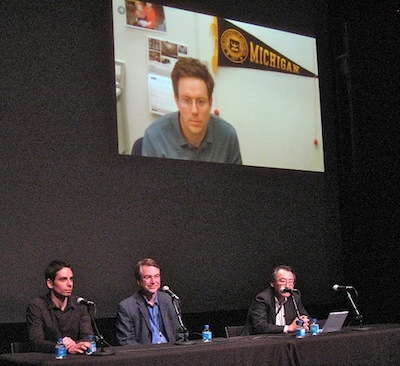Sponsored by NTT Network Innovation Laboratories; Hosted by Calit2/UCSD, San Diego, California
February 7-9, 2010
Ratko Jagodic (seated far left) participating in the ON*VECTOR CSCW panel. Photo: Natalie Van Osdol
ON*VECTOR (Optical Networked Virtual Environments for Collaborative Trans-Oceanic Research) is a joint project of NTT Network Innovation Laboratories, Keio University’s Institute for Digital Media and Content (DMC), the University of Tokyo’s Morikawa Laboratory, the University of Illinois at Chicago’s (UIC) Electronic Visualization Laboratory (EVL), and the California Institute for Telecommunications and Information Technology (Calit2) at the University of California, San Diego (UCSD), and managed by Pacific Interface Inc (PII).
[download id=”5″ format=1]: Improving SAGE Capabili ties for Computer Supported Cooperative Work (CSCW) – Ratko Jagodic, UIC/EVL (One of 4 speakers in a CSCW panel.)
[download id=”4″ format=1]: Movie: SAGE Interaction.
Demonstrations of SAGE and multi-rail aware, high performance, flexible data transfer application using TLAN technologies
Osamu Kamatani, NTT Network Innovation Labs, Sungwon Nam and Luc Renambot, UIC/EVL. NTT had several demonstrations. SAGE was used to stream input from multiple sources to a tiled display at Calit2/UCSD, including high-definition video of people in Japan. The multi-rail demo did not use SAGE; NTT showcased enhanced network streaming performance using its rail-aware parallel streaming application to exploit parallelism – to effectively utilize the computer’s multiple processors, and multiple cores per processor, in order to quickly process animation flows. Animations were sent to two different computers connected to two halves of the Calit2 tiled display – one running multi-rail software and one not. Given that the multi-rail software makes computer hardware run more efficiently, the animation processed by the computer running the software was displayed without problem. The animation processed by the other computer had a lot of noise when displayed due to packet drop.
